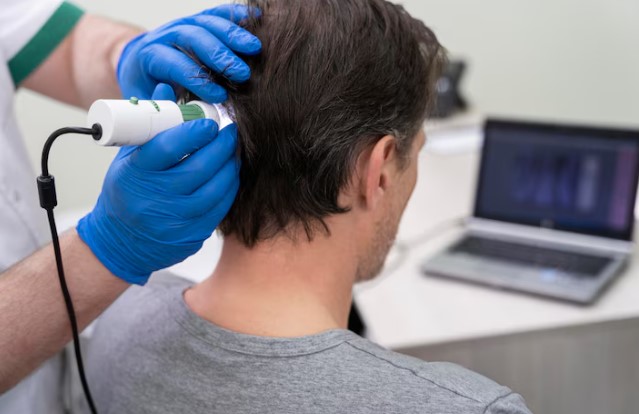
Hair loss is a common concern that can significantly impact your confidence. Among the various treatments available, PRP (Platelet-Rich Plasma) and FUE (Follicular Unit Extraction) hair transplants are popular options. This article explores the differences between these two methods and helps you decide which might be better suited for your needs.
What is FUE Hair Transplant?
FUE is a surgical hair restoration technique where individual hair follicles are extracted from a donor area and transplanted to the thinning or balding parts of your scalp. This method is known for its minimally invasive nature, reduced scarring, and natural-looking results. The procedure involves local anaesthesia and can take several hours, depending on the extent of the area to be treated.
The FUE technique involves using a specialised tool to create tiny, circular incisions around each hair follicle, which are then carefully extracted. These follicles are then implanted into the target area, where they will grow and blend seamlessly with your existing hair. One of the primary advantages of FUE is the minimal scarring, which makes it an attractive option for those who prefer short hairstyles.
The recovery period for FUE is relatively short, with most patients returning to normal activities within a week. The results are permanent, as the transplanted hair follicles are resistant to the effects of dihydrotestosterone (DHT), the hormone responsible for pattern baldness.
What is PRP Hair Treatment?
PRP hair treatment involves drawing a small amount of your blood, processing it to concentrate the platelets, and injecting the platelet-rich plasma into your scalp. The growth factors in PRP are believed to stimulate hair follicles, promoting hair growth and improving hair density.
PRP is a non-surgical treatment that has gained popularity due to its natural approach to hair restoration. The process begins with a blood draw, typically from your arm. The blood is then placed in a centrifuge to separate the plasma from the red and white blood cells. This plasma, rich in growth factors, is injected into your scalp in areas experiencing hair thinning or loss.
PRP therapy is often used as a stand-alone treatment for hair loss, but it can also complement hair transplant procedures. By enhancing the health of existing hair follicles and stimulating new growth, PRP can improve the overall results of hair restoration treatments. Multiple sessions are usually required to achieve optimal results, and maintenance treatments may be necessary to sustain hair growth.
Is FUE or PRP Better?
The choice between FUE and PRP largely depends on your specific needs and the extent of your hair loss. FUE is generally preferred if you seek a more permanent solution to baldness, especially in cases of significant hair loss. This surgical method provides lasting results by transplanting hair follicles that are genetically resistant to hair loss.
On the other hand, PRP might be more suitable if you want to improve hair thickness and density without undergoing surgery. PRP is ideal if you are in the early stages of hair loss or if you want to enhance the results of a hair transplant. The non-surgical nature of PRP makes it a more attractive option if you prefer less invasive treatments with minimal downtime.
Is It Better to Do PRP After Hair Transplant?
PRP can be used in conjunction with hair transplants to enhance the results. Post-transplant PRP treatments can help speed up the healing process and stimulate faster and thicker hair growth in the transplanted areas. Combining PRP with FUE can provide more robust outcomes, ensuring that your new hair grows in healthier and stronger.
Using PRP after a hair transplant can help reduce inflammation and promote healing, which can lead to better graft survival and faster recovery. The growth factors in PRP can also improve the overall health of your scalp, creating a more favourable environment for the newly transplanted hair to thrive.
Is PRP Cheaper Than Hair Transplant?
PRP is generally less expensive than FUE hair transplants because it is non-surgical and requires fewer resources. However, because multiple PRP sessions are often needed to achieve and maintain desired results, the costs can add up over time. FUE, while more expensive upfront, is typically a one-time investment that provides lasting results.
The cost of PRP therapy varies depending on the number of sessions required and the geographic location of the clinic. Although PRP may have a lower initial cost compared to FUE, the need for ongoing treatments can result in higher long-term expenses. You should factor in the potential need for maintenance sessions when evaluating the overall cost.
Is PRP Required for Hair Transplant?
PRP is not required for a hair transplant but can be a valuable addition. It is often recommended by surgeons to support the healing process and improve the final outcomes of the transplant. However, FUE can be performed successfully without PRP, and many patients achieve excellent results with the transplant alone.
Incorporating PRP into a hair transplant procedure can enhance the overall success of the treatment by promoting faster healing and improved graft survival. PRP can also help reduce post-operative swelling and discomfort, making the recovery process more comfortable for you. While not essential, PRP can be a beneficial adjunct to hair transplant surgery.
PRP or Hair Transplant: Which is Better for You?
If you have extensive hair loss, FUE is usually the better option as it provides a permanent and effective solution to significant baldness. The ability to transplant hair follicles that are resistant to hair loss ensures lasting results, making FUE a preferred choice if you have advanced hair loss.
If you have thinning hair, PRP can be beneficial for improving hair thickness and density without the need for surgery. PRP is suitable if you are in the early stages of hair loss or if you want to enhance the density of your existing hair. Its non-surgical nature and minimal downtime make it an attractive option for those seeking a less invasive treatment.
If you are seeking a non-surgical option, PRP is ideal due to its minimally invasive nature and shorter recovery time. PRP therapy is a quick and relatively painless procedure that can be performed in an outpatient setting. You can resume your normal activities immediately after treatment, making PRP a convenient option for busy individuals.
If you are looking for permanent results, FUE offers a lasting solution, making it preferable if you are looking for a one-time treatment.
In conclusion, both PRP and FUE have their unique benefits and can be effective in treating hair loss. The best choice depends on the extent of your hair loss, the desired outcome, and your preferences. Consulting with a qualified hair restoration specialist can help determine the most suitable approach for your specific situation.








